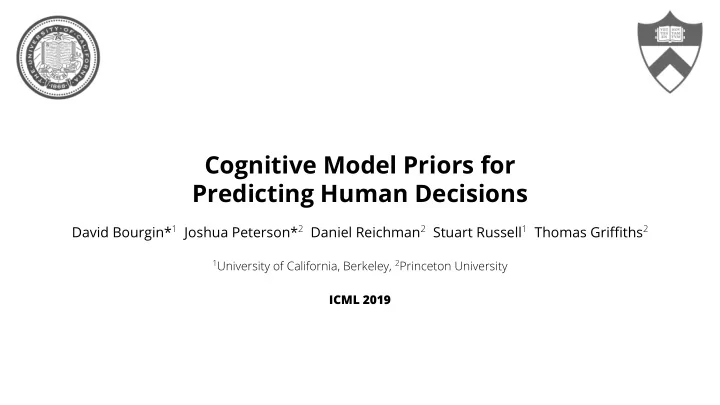

Cognitive Model Priors for Predicting Human Decisions David Bourgin* 1 Joshua Peterson* 2 Daniel Reichman 2 Stuart Russell 1 Thomas Griffiths 2 1 University of California, Berkeley, 2 Princeton University ICML 2019
Predicting human behavior is important for... Economics Psychology AI-human Alignment
Two Approaches
Two Approaches Behavioral Science Step 1 Observe behavior Step 2 Create theory / model
Two Approaches Behavioral Science Machine Learning Step 1 Observe behavior Step 2 Create theory / model
ML can be very effective, but needs lots of data Machine Learning Models Predictive Accuracy Dataset Size
ML can be very effective, but needs lots of data Machine Learning Models Most Predictive behavioral Accuracy datasets Dataset Size
ML can be very effective, but needs lots of data Machine Learning Models Predictive Accuracy Cognitive Models Dataset Size Cognitive models need less data, but improve slower
Cognitive Model Priors
Cognitive Model Priors 1. Use a cognitive model to generate synthetic behavioral data 2. Pretrain a neural network on this synthetic behavior 3. Fine-tune the pretrained network on real human responses
Cognitive Model Priors 1. Use a cognitive model to generate synthetic behavioral data 2. Pretrain a neural network on this synthetic behavior 3. Fine-tune the pretrained network on real human responses
Cognitive Model Priors 1. Use a cognitive model to generate synthetic behavioral data 2. Pretrain a neural network on this synthetic behavior 3. Fine-tune the pretrained network on real human behavior
Case Study: Risky Choice Choices that involve uncertainty & monetary gain/loss ● Multiple models developed over decades ● Kahneman & Tversky (1979) Peysakhovich et al. (2017) Erev et al. (2017)
Task is to choose between two gambles
A gamble is a collection of outcomes ( rewards ) & their probabilities
One of these is then sampled
Feedback: You chose B and gained 50 Had you chosen A, you would have gained 16
Cognitive Models of “risky” decision-making (between gambles)
Cognitive Models of “risky” decision-making (between gambles) Approach Specify the subjective value of a gamble 1. Choose gamble with highest value 2.
Cognitive Models of “risky” decision-making (between gambles) Approach Specify the subjective value of a gamble 1. Choose gamble with highest value 2. Lots of models we could use... ...
Cognitive Models of “risky” decision-making (between gambles) Approach Specify the subjective value of a gamble 1. Choose gamble with highest value 2. Lots of models we could use... We used SOTA: “ BEAST ” Estimates expected value (payoff) with ● biased, sampled-based, estimators We treat as black box with inputs/outputs ● ... Erev et al.. Psychol. Rev. , 2017, 124 , 369. Plonsky et al. 2019, arXiv preprint arXiv:1904.06866.
CPC15 and CPC18 competition datasets are still small by ML standards
Machine learning struggles when learning from raw inputs and scarce data
Hand-built cognitive models do much better
Machine learning with lots of feature-engineering finally shows improvements 2015 winner Our 2018 winning entry
Our method outperforms them all Better than our CPC18 winner
Result: choices13k dataset 13,000 pairs of gambles ● 240k individual decisions ●
Result: choices13k dataset 13,000 pairs of gambles ● 240k individual decisions ● ✖ Classic Experiments • Previous Benchmark (CPC) • Ours: choices13k
New dataset lets us compare different levels of data scarcity ...
When data is scarce, cognitive model priors improve generalization
When data is scarce, cognitive priors reduce training time
Predicting human behavior is important for... Economics Psychology AI-Human Alignment Cognitive model priors improve accuracy and reduce training time
Cognitive Model Priors for Predicting Human Decisions David Bourgin* Joshua Peterson* Daniel Reichman Stuart Russell Thomas Griffiths Co-authors Thomas Griffiths Joshua Peterson Daniel Reichman Stuart Russell Poster #244 Funding Wednesday Evening DARPA Future of Life Institute Open Philanthropy Project ddbourgin@gmail.com National Science Foundation peterson.c.joshua@gmail.com
Recommend
More recommend